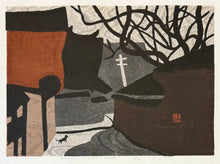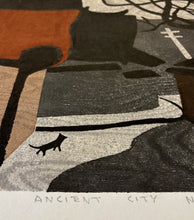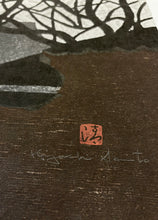artist: Kiyoshi Saito (Japanese 1907-1997)
medium: original wood block print
dimensions: 53 x 38cm image size / 60 1/2 x 48 cm print size / 73 x 59 cm frame size (approx)
limited edition 44/100
hand signed in pencil
dated 1954
plus red artist's seal in the image
* presented in a new hand finished timber frame with double thick archival mat and backing, non-reflective UV museum glass - photos to follow shortly
AU $2425 (approx US $1515 / 14555 EUROS / 238,000 yen / 1200 GBP - for exact current conversion visit xe.com)
artist biography
Kiyoshi Saito (1907-1997) was one of the most important Japanese woodblock print artists of the 20th century. Originally trained as a painter, Saito became a pivotal member of the "Sosaku Hanga" or "Creative Print" movement in the Post-war period, attracting international audiences and accolades. In the spirit of Sosaku Hanga, he engaged with every aspect of the printmaking process, meaning that each of his works is self-drawn, self-carved and self-printed. While his early works reveal an attention to three-dimensionality, as his style evolved, his designs became increasingly two-dimensional, distinguished by bold blocks of color, refined designs, and rich texture.
Born in Fukushima prefecture on April 27th, 1907, Kiyoshi Saito moved to Otaru in Hokkaido at the age of five. As a teenager he worked as the apprentice to a sign painter and opened his own sign painting business by 20. He became infatuated with art after studying drawing with Gyokusen Narita, a local teacher and acquaintance of the Sosaku Hanga print artist Shiko Munakata. In 1932 Saito sold his shop and moved to Tokyo to study painting. While he made his living through illustration and sign painting, he studied yoga (Western-style painting) at the Hongo Painting Institute in the evenings. He began experimenting with woodblock prints and submitted his prints along with his paintings to the Kokugakai exhibition in 1937. Though his paintings were accepted, his prints were not. Discouraged, Saito mainly exhibited his oil paintings until his invitation from Tadashige Ono to join the print group Zokei Hanga Kyokai in 1939. Saito joined and turned to the woodblock print as his primary medium. While working at the Asahi Newspaper Company in the mid-1940s, he met Koshiro Onchi, a mentor of the Sosaku Hanga movement. This chance encounter led to an invitation to another print group, Ichimokukai, setting him on a path to international fame.
Saito’s printmaking career was put on hold due to the war. During the occupation, he sold his first woodblock print in an exhibit with fellow artists Un’ichi Hiratsuka and Hide Kawanishi. In 1948, Saito exhibited at the Salon Printemps, an event sponsored by Americans for Japanese artists. At the Sao Paulo Biennale of 1951, Saito won first prize for his print Steady Gaze. In competition with Japanese oil painting and sculpture, this honor marked a turning point for Japanese print artists: for the first time in Japanese history, prints overtook painting. This achievement roused the Japanese art establishment and shifted the perception of the print medium. In 1956, Saito was sponsored by the State Department and the Asia Foundation to travel and exhibit around the United States and Europe. His work became particularly popular among Western collectors during the 1950s and 1960






